I’ve been around the block when it comes to sales: after starting my career selling tickets for college athletics, graduating to the sales ops side of pro sports, making the move to selling financial services. Most recently, I have been enjoying the SaaS world as a sales rep.
One of the similarities across these teams is the communal groan and eye roll that comes with a new mandatory training program, with 360Learning being a remarkable exception. 😁
Us sales folk generally care about one thing - closing deals. This lead conversion tunnel vision comes with some drawbacks. Training is looked at as something that gets in the way of doing our job.
This needs to change. A recent study performed by CSO Insights shows that organizations with continuous sales training programs saw:
- 49% lower annual turnover
- 12% higher win rates
and yet... - 9% of sales training programs exceed expectations
This latest article from Mckinsey also highlights the urgency for companies to accelerate training for sales teams as many shift to remote work and adopt new ways to manage customer relationships post COVID-19.
Long story short, sales training is crucial; It makes a real difference. The only problem? Most sales training suck.
So, we are left asking ourselves, how do we make sales training not suck? And more importantly,
How do we create training that gets salespeople excited?
How do we create training that gets salespeople excited?
1. Match training to sales reps’ pain points
This is sales technique 101: present your value in a way that targets a pain point. Salespeople care about being able to close deals right now, this month, and this quarter. Courses and training content needs to explicitly give them the tools to do that.
You are now likely asking yourself, what are my sales teams’ pain points?
The discovery phase is one of the most important parts of the sales process. It is that essential first step when you dedicate a conversation to learning about your prospects’ pains, challenges, goals, and wildest daydreams. This isn't the time for your sales pitch. So here’s my first tip: make discovery a crucial part of your training creation process.
There are countless ways to understand your audience's pain points. Here are two:
- Manager/Coach Interviews: Grab a coffee (or tea, ….really any beverage) with the people who are seeing employee trials and tribulations on a daily basis. You can be certain that the SDR coach has some ideas for what would take their team to the next level. Go ask them!
- Reverse engineer company goals: Look at what your company and departmental goals are in the next few years. What are the skills that are going to get you there? Then create relevant courses that help close those gaps. Here are some examples:
- Are you going to be doubling the size of your sales team? Create some courses on coaching - you will need some new leaders to support growing numbers.
- Are you going to be taking on a new go-to-market? That means new competitors your sales needs to know about. (Believe me, we have made ourselves courses on all the other learning and training tools out there. 😉)
Of course, having a dedicated tool makes it easier. My personal favorite is the Learning Need functionality in 360Learning. I can declare a learning need - this is any topic that I want to learn more about. My colleagues can give it upvotes and someone can volunteer to make that course a reality.
Here is a perfect example of the learning needs in action. Objection handling is vital to hitting quota - and we make it known!
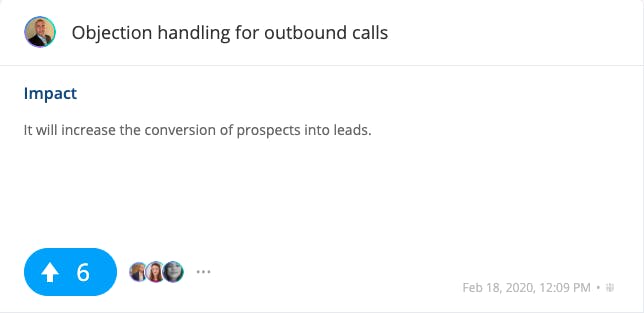
The next thing we know… Carl has raised his hand and shared his knowledge in a course.

Related: The Right Way to do a Training Needs Analysis
You have matched your team’s pain points and, in turn, some incredible courses are being created. Training is no longer being looked at as a support function, but a driver of growth.
What else can you do to keep this train running?
2. Facilitate Peer-To-Peer Learning
As humans, we love interaction, collaboration, and sharing ideas. Salespeople are no exception, in fact, most people go into sales because they love human interactions.
Across the board, people learn more efficiently when human interaction and collaboration is involved. Research from Learning Solutions Magazine shows that 75% of workplace knowledge transfer comes from social activity.
Obviously, this sounds perfect. Just take a step back and let everyone learn from each other. How do you actually make that happen?
Build feedback into everything
I am receiving and giving feedback constantly. It is one of the pillars that 360Learning stands on as a tool and as an organization.
Here are some examples of what that looks like on our platform:
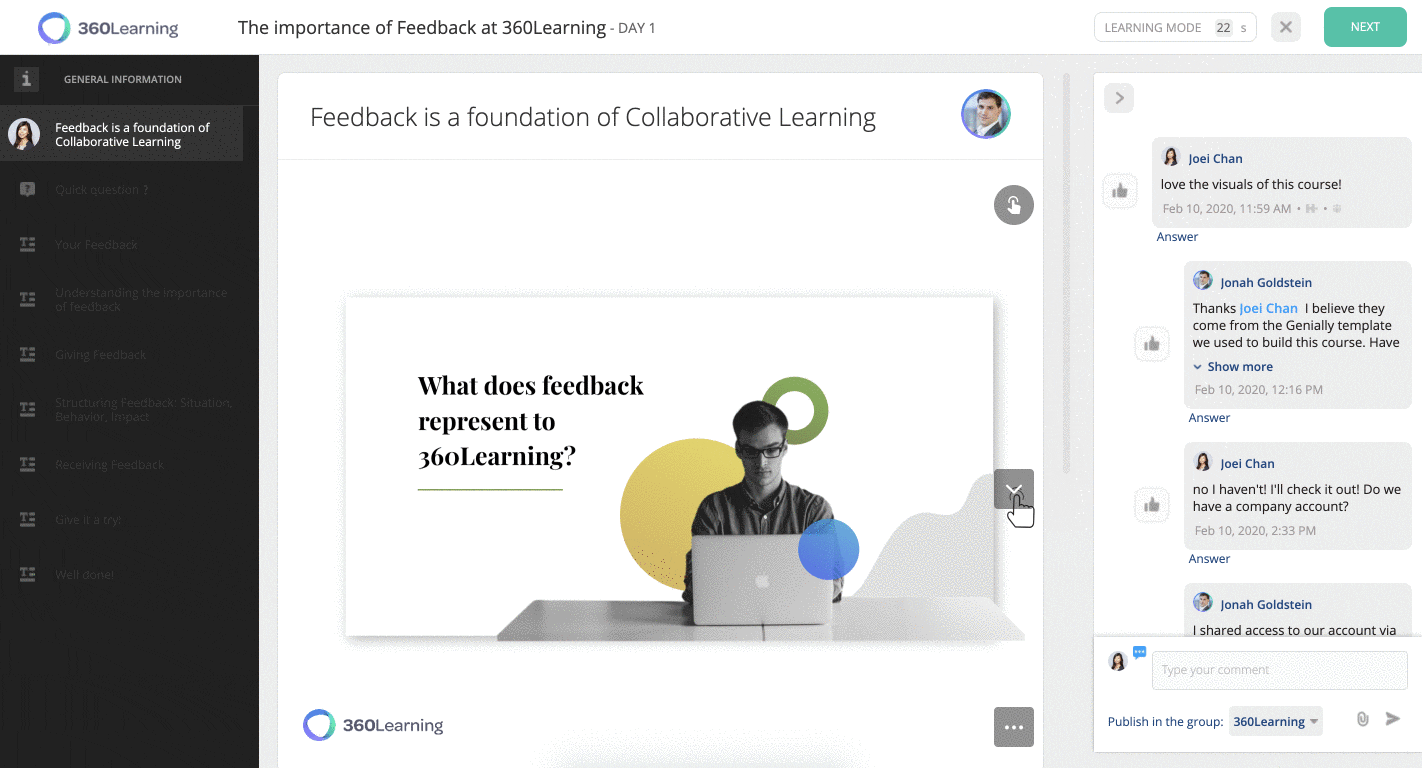
Of course, you don’t need a tool like 360Learning to build a dialogue through feedback (It definitely helps though 😉) Here are two ways kickstart peer-to-peer learning:
- Q&A Sessions: Remember in school when they broke you into smaller groups to discuss a topic? I always really enjoyed and benefited from that. We do it all the time.
Q&A session? Really? Is that really an effective way to engage people in training? You may ask.
The answer is, yes! If you do it right. In our case, a small group sitting down with a product manager to discuss their latest product release. We can use that information today to hop on the phones and build our pipeline. A Q&A session does a lot of work to contribute to a culture of knowledge sharing. - Roleplays: The best role play sessions I’ve ever had were with my peers. Our team assembled in a conference room once a week for 30 minutes. A scenario was proposed (i.e. cold call opening) and we would bounce around the room for 10 minutes practicing with each other and then move on to the next scene. We all would become better players and coaches through this process. Gathering in a conference room is not always an option. Thankfully the 21st century has afforded us countless ways to bring this online.
Matching pain points and facilitating peer-to-peer knowledge is great. But it can’t give people more hours in the day.
While we haven’t quite figured out time travel yet, there is something you can do that has nearly the same effect.
Related: How We Use Peer Learning to Keep Our Company’s Competitive Edge
3. Leverage microlearning
Microlearning is one of the terms that gets thrown around all the time without anything concrete. The idea is simple. We absorb information more efficiently when it is broken into small pieces. Learn more in less time. Sweet.
How do we turn this idea into something that’s helpful? Think outside the course and think at the point of need.
Microlearning is the most powerful when it can be accessed quickly when we need it most (i.e. before a big call or meeting)
Here are some quick pieces of information that can turn into valuable microlearning tools.
- Customer reviews
- Call scripts
- Customer analytics
- Recent Industry Reports
- Competitor information
This micro-lesson, in particular, saved me a significant amount of time.
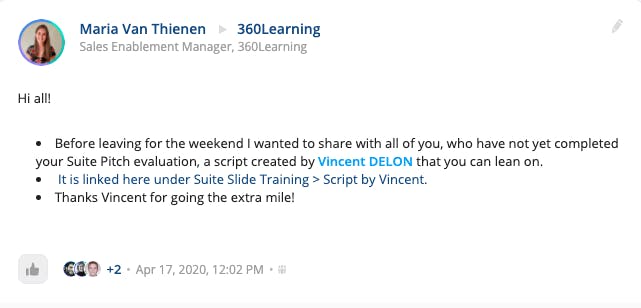
Other than a full-on course, micro-learning can also come in the form of simple content sharing. In fact, that's how I discovered the Mckinsey article cited in the intro:
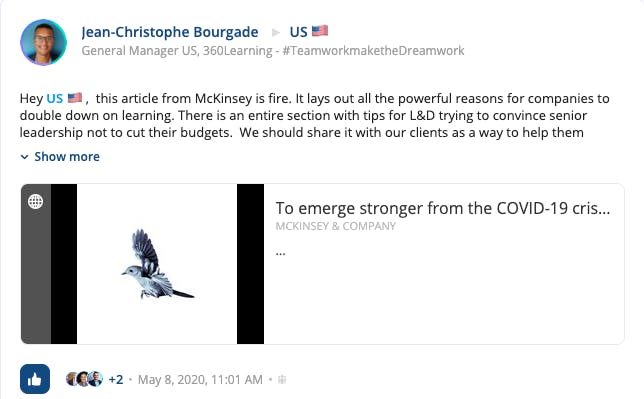
There are really no limits to micro-learning. We even turn some inspirational quotes into opportunities for micro-learning.
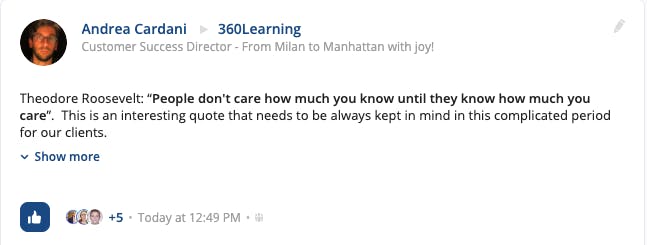
Micro-learning is my favorite form of sales training. Our lives are already complicated enough. Training should be simple.
Delivering great sales training takes practice
Great sales training, like a great sales pitch, takes practice and time. There are also too many tools to create a great sales training program to fit into one blog post. This is something that I had to grapple with while putting this together for you.
What I’ve shared here are three basic steps to engage any salesperson in quota crushing training. Start by incorporating these tips into your onboarding, weekly meetings, and role-based training. Of course, this is just a start. Sales training, like sales, is hard and takes a lot of trial and error.
Here are some additional resources to help your sales teams achieve their very best results:


